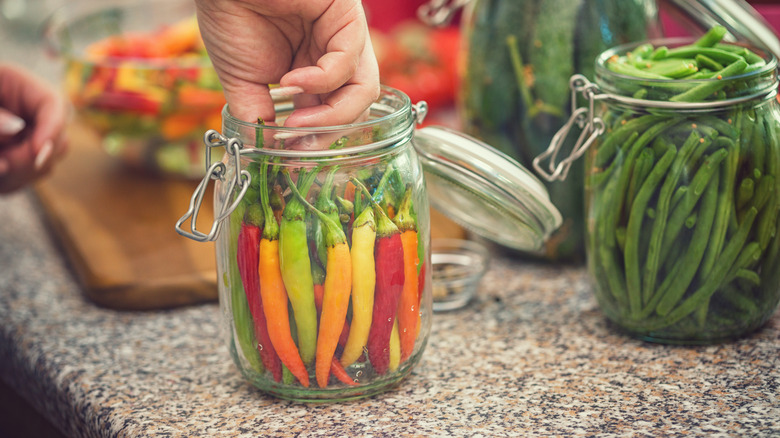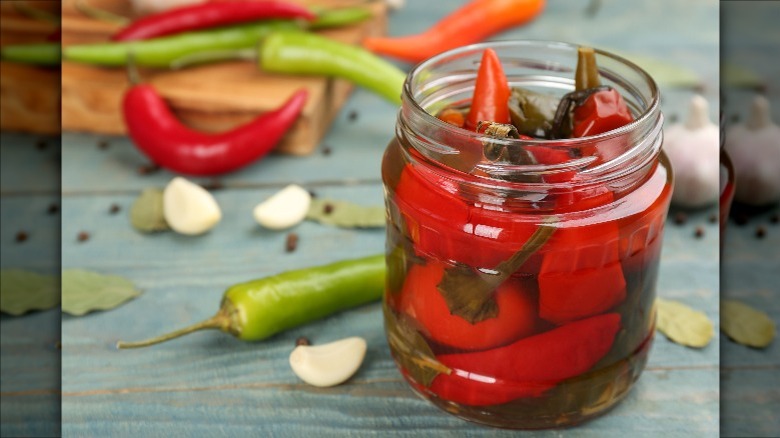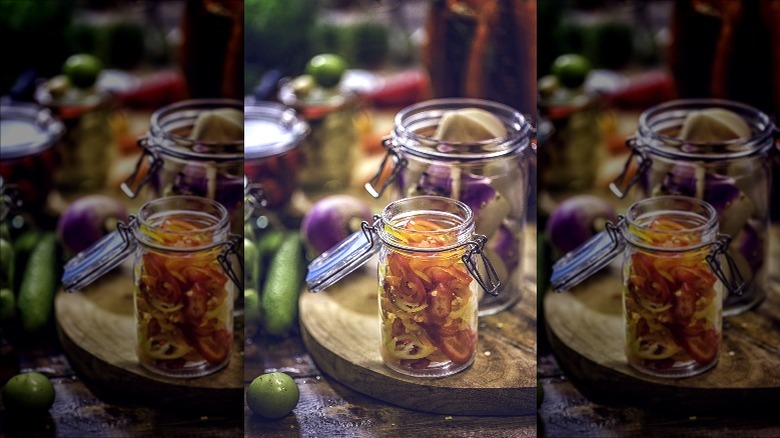Perfect Pickled Peppers Take Way Less Time Than You'd Think
If you love the briny taste of pickled peppers, but loathe the long canning process that comes with DIY preserved foods, try quick pickling them instead. With mere minutes of active work and a few hours of waiting, you can make perfect pickled peppers that will pack a punch in salads, salsas, sandwiches, pizza, and plenty more dishes.
Pickling typically involves soaking ingredients in a brine of salt, sugar, and an acid — usually vinegar, but you can also use citrus like lemon juice for a milder flavor. It's also common to add herbs, spices, and aromatics like garlic and onions. While quick and traditional pickling use the same ingredients for the brine, quick pickling leaves out the process of sterilizing and sealing the jars with heat. This step is a must for pickles that last for months, even at room temperature, but if you want a smaller amount of pickled peppers that you plan to eat fairly soon, quick pickling is the much easier way to go.
To try it, just load up a jar with peppers, pour in the hot brine, let it cool, and refrigerate for up to eight hours, allowing them to soak up the solution. You can eat them as soon as they cool, but they won't have the fullest flavor quite yet. Quick pickled veggies must be refrigerated, and only last a couple of weeks or months, depending on the recipe.
What types of peppers can be pickled?
There are lots of varieties to choose from when it comes to picking a pepper to pickle. Many sweet, mild, and hot peppers work well for pickling, but just remember that the fresher the pepper, the better. Ensure they are firm, bright in color, and not shriveled or overripe for the best-tasting pickled peppers.
For a briny-sweet pepper perfect for salads or snacking, try pickling bell peppers. Any sort of color, from red to green and yellow, will do. Or, for a salty taste with a touch of heat, try making homemade pickled banana peppers or pepperoncini, which are perfect for pizzas, sandwiches, and pasta. Pickled pepperoncini are also the slept-on ingredient for more robust chili. As a bonus, the leftover banana pepper brine is your secret weapon for perfectly spicy martinis. You get the tanginess of the vinegar with a hint of refreshing heat.
To turn up the heat even more, try pickling hot chili peppers like jalapeños, Hungarian hot peppers, or serranos. Hot or mild pickled peppers are your new go-to ingredient for the best salsa ever. You can also make your own cherry bombs, the hot cherry peppers that will elevate any Italian dish. The bright red, round peppers are often stuffed with cheese and prosciutto, or sliced and sautéed for a pasta dish. Of course, they're also delicious on burgers for those with a higher spice tolerance.
Customizing the brine
There are endless possibilities for making the brine for your peppers. Most brine solutions contain salt and one or more types of vinegar such as distilled white vinegar, rice vinegar, white wine vinegar, and apple cider vinegar. White vinegar is the standard option and a good choice for fans of a super tangy brine. Apple cider vinegar, on the other hand, has a touch of sweetness and a golden brown color that may slightly color your pickled vegetables. Rice vinegar and wine vinegar are also less tangy and sweeter than white vinegar.
You can further customize your brine solution by choosing your favorite herbs and spices to boost the flavor. Commonly used add-ins include mustard seed, whole peppercorns, red pepper flakes, coriander, cloves, bay leaves, and garlic. Sweeten it up with some cinnamon sticks, ginger, or allspice. Bear in mind that using too much powdered or ground spices might be overwhelming in your brine, so try using fresh, whole spices and herbs that can impart the perfect amount of flavor.
Another useful tip when making the brine is to cut large peppers into slices or pieces, which will help the flavor soak into the peppers and make using them straight out of the jar easier. You can leave smaller peppers whole, just make a couple of cuts to allow the brine to get inside. Removing the seeds will also help reduce the spiciness of hot peppers.


